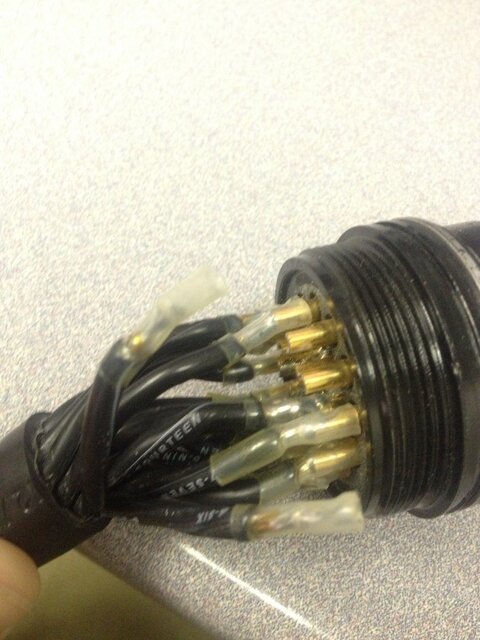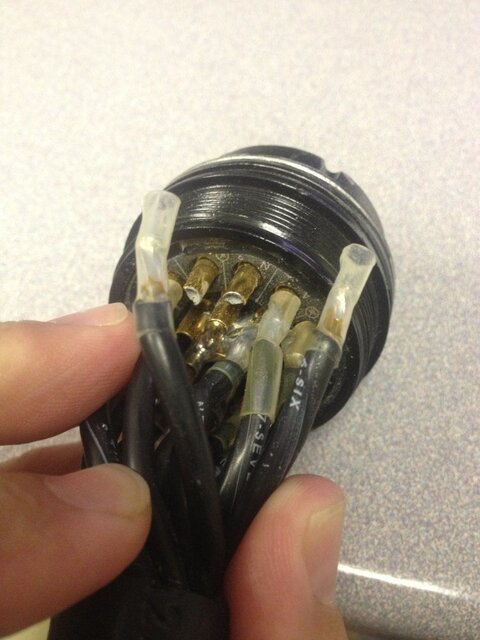Try adding some flux to the pins using a flux pen or similar before re-soldering. It will help clean any oxidation and ensure that the solder flow better. Footer is right about the heat. Those pins are bigger and have a higher thermal capacity, so you need more heat over a longer period of time.
Got an alert when I checked into the website about this. Creative
Stage Lighting should have a full warranty and I would have them pay for shipping both ways so as to correct this. LK is only sold by them and while you can do the
heat shrink over terminals as necessary, it is easier to
send it back. A training type of thing in properly terminating
Soco cable in solder style. More expensive start up but I use
crimp terminals if not the molded from Lex or TMB. Interesting note about harder to mate the Lex molded, have not heard that yet. Onto if you have to repair... as best I can help.
More heat over a longer period of time is a bad thing in melting stuff other than what you need to heat up with other than a cold solder or burnt conductors. I started with a soldering gun.... no, retire it in not working best or dependable.
Flux pen, perhaps not a bad idea, but unless cutting all the conductors and starting over, the flux or acid in your solder should be sufficient, and the flux won't help in re-attaching partially tinned
wire back to a
terminal. In general a 0.050" acid core solder should be fine to solder a 12ga stranded
wire to a 12ga pin. This if you have the right tools and technique.
In general a 0.050" 63/37% acid core solder should be fine to re-solder a 12ga stranded
wire to a 12ga pin, or refresh it in re-soldering it properly. There is already solder on the
wire, need to re-fresh it with new solder and the acid core is needed for the attachment so as to properly refresh what you are doing. The flux won't do this in making a good flow and doing the soldering of partially tinned or cold solder to the pin.
This also if you have the right tools. I have a Weller WES51 60w
iron at home and a even more powerful one at work. Don't use the tip of the pen... you are not painting or doing electronics, you are trying to transfer heat to a larger
gauge of cable and it requires surface area that the side and much thicker part of the
iron will better convey. This means both more or less the side of the
stock tip or a like 3/32" wide screwdriver tip in use. - Not some pointy electronics tip. Add fresh solder to it so as to help further transfer the heat in surface area and acid flow to activate or re-activate the old solder. Soldering
Iron goes up to about 850 degrees, you should max it out for this wattage of
iron in use on that size of
wire.
After that, how you hold the solder, the
iron etc. is amongst many styles and for those I train I train them,
send them to someone else, than
send them to someone else yet in learning various techniques so they can develop their own style. Until you can both heat with application with some solder, and add some more properly - but not too much, those in training get inspected on everything they do. Had a large project a few weeks ago for some lamp bar types that used solder reinforced grounding rings on the
Soco plugs. Pulled in everyone from the shop that was trained for soldering for it, including military trained people. Soldering 12ga. isn't something one normally is trained to do and should require some professional instruction before you attempt. Plus it took them over double the time to even get ok at doing it.
Here is the thing about solder
Soco's. If soldered correctly, they will work perfect and for ever. It doesn't take like $500.00
thru $750.00 and above in buying tools to
crimp them properly and insert/removal tools for working on them. Just over $100.00 proper soldering irons and technique to make them work. Pneumatic version of the
crimp tool is like three times more expensive but is worth it if doing bulk - love it.
On the other
hand, should you get a
voltage spike/lightnight
spike or something like a cold solder, you could wind up with a pin or many of them that get overheated in resistance to
current flow. This resistance could heat up enough that the solder begins to flow again. (Got lucky that the
wire just removed itself from the pin - probably pins like 11 or 12 inner core conductors with "cable stretch" in your situation with the rest on the cable suspect.) It happens a bad lot for cable, but also happens - this resistance heat buildup cold solder or even proper solder if a good
spike in making for "liquid electricity" inside the
plug - and could happen anywhere in your
system where it finds a cold solder or soldered
plug in adding resistance. Could be 40' up in the
grid, a
plug with a
bit too much solder about it's terminals, or something near with a cold solder, or any combination.
Once the solder begins to flow in getting hot enough due to high resistance
current or especially
current surge, it flows by way of gravity. Reason for the
heat shrink is to prevent wires / debree inside the
plug / pin tops or too far stripped or pulled back
wire from touching, but only some to prevent solder from melting between pins. Solder hot enough,
heat shrink is gone and solder is a liquid in finding gravity.. Still though het shrink is the proper thing to do.
I use adhesive lined
heat shrink. It's only
hot glue and doesn't bond well with the
conductor jacket, but any help for
insulation on cable stretch is a good thing.
Only reason I do soldering on
Soco is for the grounding ring if not working on a old serviceable
plug that I surpervise soldered pins to. I always do the soldered reinforced grounding ring - always. The grounding ring is reinforced by a ring of copper foil between the pins inside the grounding ring. As little as needed to in solder bond the ring to the pin. Again the liquid electricity thing.
Repairing
Soco cable properly is not for other than trained in doing so and proper tools. I recommend sending it back for warranty and engauging with a company even them for proper training and buying the proper tools.






